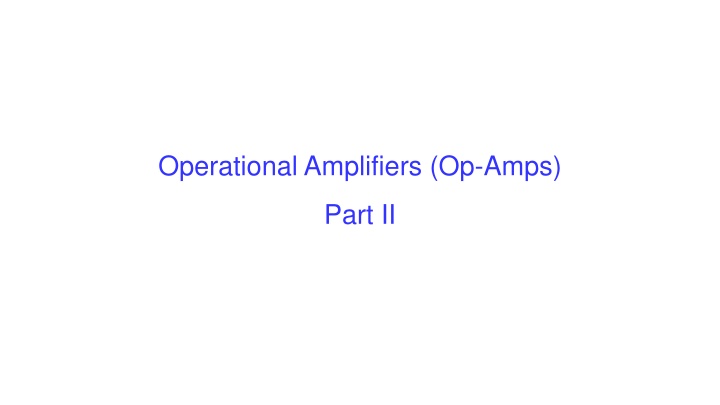
Understanding Operational Amplifiers: Part II
Explore the block diagram and operation configurations of operational amplifiers (Op-Amps), including input modes like inverting and non-inverting, common mode, and differential mode. Learn about the components and stages of an Op-Amp circuit for better comprehension. References to key textbooks provided.
Download Presentation

Please find below an Image/Link to download the presentation.
The content on the website is provided AS IS for your information and personal use only. It may not be sold, licensed, or shared on other websites without obtaining consent from the author. If you encounter any issues during the download, it is possible that the publisher has removed the file from their server.
You are allowed to download the files provided on this website for personal or commercial use, subject to the condition that they are used lawfully. All files are the property of their respective owners.
The content on the website is provided AS IS for your information and personal use only. It may not be sold, licensed, or shared on other websites without obtaining consent from the author.
E N D
Presentation Transcript
Operational Amplifiers (Op-Amps) Part II
Block Diagram of an Op-Amp An operational amplifier is a direct coupled high gain amplifier consisting of one or more differential (OPAMP) amplifiers and followed by a level translator and an output stage. An operational amplifier is available as a single integrated circuit package. The Input Stage is a dual input balanced output differential amplifier which provides most of the voltage gain of amplifier and also establishes the input resistance of op-amp. The intermediate stage of OP-AMP is another differential amplifier which is driven by the output of the first stage. This is usually dual input unbalanced output.
Because direct coupling is used, the dc voltage level at the output of intermediate stage is well above ground potential. Therefore level shifting circuit is used to shift the dc level at the output downward to zero with respect to ground. The output stage is generally a push pull complementary amplifier. The output stage increases the output voltage swing and raises the current supplying capability of the OPAMP. It also provides low output resistance.
Configuration of Op-Amp Operation Closed Loop Configuration Open Loop Configuration
Op-Amp Input Modes Inverting Mode
Common Mode Differential Mode
References 1. Ramakant A. Gayakwad, Op-Amps and Linear Integrated Circuits, Pearson, 2000. 2. Robert L. Boylestad, Louis Nashelsky, Electronic Devices and Circuit Theory, Pearson, 2013.
